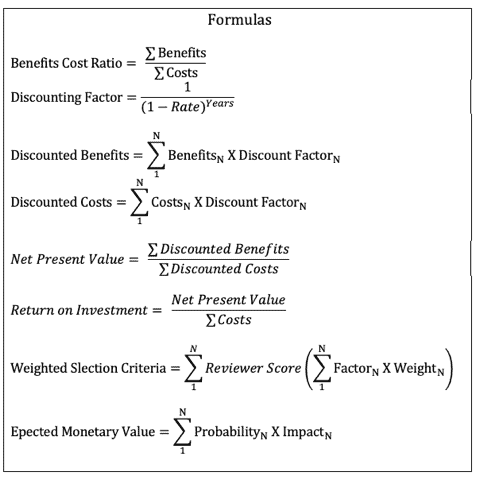
Economics is the social science that studies making choices subject to constraints. Project, program, and portfolio managers make economic decisions daily. We try to maximize value delivery subject to the constraints of time, cost, quality, risk, and resource availability.
Economics can help project managers make more informed decisions. It provides frameworks to evaluate different options and make informed decisions objectively. Economics does not need to be complicated. Understanding the available tools and employing them creates the opportunity to make better choices. This article provides an overview of common frameworks.
Creating Data
Finding “good” data is often the most significant challenge. After all, we are trying to predict the impact of future events. Once we have the data, calculating and analyzing the output is generally straightforward.
The British economist John Maynard Keynes said, “It is better to be roughly right than precisely wrong.” Our analyses do not need to be precise. They simply need to provide more information and insight than we currently possess.
The book How to Measure Anything describes frameworks and tools for estimating things that initially seem complicated. Estimating the actual dollar costs and benefits of a project or decision may be complicated. But we can use proxies to assess the relative size or impact of different items, which facilitates the comparison.
T-shirt or bucket sizing is commonly used to create high-level estimates. We sort items into relative sizing brackets of small, medium, large, and extra-large. We can then apply numeric values (e.g., 1, 3, 5, 8, 13) to convert our sizes into quantitative data to drive our analysis.
Cost-Benefit Analysis
Cost-benefit, or more accurately named benefit-cost ratio, is a commonly used tool. It is the ratio of the intended benefits divided by the expected cost. This is an easy and quick measure to compute. However, it should be limited to short-term decisions because it does not incorporate the time value of money.
The analysis can be used to understand whether a project has a net positive (proceed) or negative (most likely do not pursue) impact. It can also be used to compare different proposed projects. Projects with the highest ratio will potentially provide the greatest value.
Computing the ratio is easy when the dollar value of the costs and benefits are available. Costs are often easier to approximate than benefits. Benefits are often projections of future performance or intangibles such as risk reduction. We can use relative-size estimates when quantitative data is not available.
Present Value and Net Present Value
Present value (PV) and net present value (NPV) are used to evaluate projects with a multi-year stream of expected benefits and costs.
Present value is the sum of the discounted future benefits (revenue). Net present value subtracts the discounted costs. These measures adjust for the time value of money. For both measures, bigger is better.
Discounting recognizes it is better to have a dollar today than a year from now. With a 10% discount rate, a dollar is worth only $0.91 a year from now and $0.39 in 10-years. Therefore, it is better to earn money sooner and pay expenses later.
Imagine you are considering investing in two apartment buildings. Both have a planned 30-year life. Total costs include the purchase price, development costs, and ongoing operating maintenance costs. The rents are the revenue stream.
For simplicity, assume that both properties’ lifetime revenue and costs are the same, which means they have identical cost-benefit ratios. The timing of these revenues and expenses may significantly impact net present value.
Assume the first building is an existing structure with a lower purchase price but higher maintenance costs. And the second building is new with higher construction costs but lower operating costs. The older building might be a better investment because the net present value is higher due to lower upfront costs.
Return on Investment
Return on investment (ROI) is calculated as the net present value divided by the project’s cost and is expressed as a percentage. Projects with a higher return on investment have the most significant economic benefit. Since ROI converts the net present value into a percentage, it is easier to compare different-sized projects.
Payback Period
The payback period is the amount of time required to recover the cost of an investment. It is calculated by dividing the upfront costs by annual benefits. The shorter the payback period, the better.
The payback period can be used to compare investments against a benchmark or assess the feasibility of several projects. Like the benefit-cost ratio, the payback period is not discounted and is generally used to analyze projects with a shorter time horizon.
My wife and I were evaluating the feasibility of installing solar panels. The project had a positive benefit-cost ratio and net present value. However, the payback period was much longer than the industry benchmark.
Weighted, Shortest, Job First (WSJF)
Weighted, shortest, jobs first (WSJF) incorporates the cost of delay in decision-making. It prioritizes jobs (e.g., projects, features, etc.) that generate the greatest value the soonest. Projects should be sequenced (ordered) based on their WSJF ratio, with higher being better.
If we were comparing three projects with the same expected benefit, we would prefer the one that could be completed first. Or, if we were evaluating projects with the same duration, we would select the one that provided the most significant benefit.
WSJF is calculated by dividing the cost of delay (benefits) by the project size. Cost of delay is a broad definition that includes revenue, time criticality, risk reduction, and opportunity enablement. Relative sizing is often used as a proxy, making it easy to conduct this analysis.
Weighted Selection Criteria

Weighted selection criteria (WSC) is a rubric that makes complicated, subjective decisions objective. WSC is used to compare and prioritize things where quantitative measures may not be available, such as vendor proposals, job candidates, projects, features, or enhancement requests.
The first step is defining the criteria to be evaluated. The relative importance of each factor is then determined, with the total equaling 100%.
The items being compared are then scored by the reviewer(s), with each factor being scored individually on a scale (e.g., 1-10, 1-100). The process easily accommodates multiple reviewers who can provide input anonymously and asynchronously, minimizing groupthink and unproductive conflict.
After all the items have been reviewed and scored, the scores for each factor are multiplied by the weight. The weighted scores are then summed. Items with the highest number are the preferred choice.
Expected Monetary Value
Expected monetary value (EMV) is a risk management tool used to assess the expected benefit of an opportunity or the cost impact of a threat. EMV is the probability of an event multiplied by dollar impact.
Sophisticated EMV algorithms are used to calculate insurance premiums. EMV can be coupled with decision tree analysis to evaluate decisions under uncertainty, such as assessing choices with different likelihoods of success and failure and expected outcomes.
© 2022, Alan Zucker; Project Management Essentials, LLC
See related articles:
- Projects and Probabilities—A Dangerous Combination
- Project Assumptions & Risks
- Project Portfolio Management: Simplify the Selection Process
To learn more about our training and consulting services or subscribe to our newsletter, visit our website: http://www.pmessentials.us/.
Image courtesy of: ThoughtCo.com
